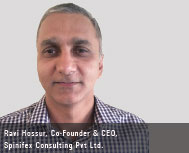
CIOTechOutlook >> Magazine >> January - 2016 issue
Cloud ERP– Will it Reign?
By
 Spinifex Consulting Pvt Ltd. provides ERP consulting services to companies. They work closely with clients to help them maximize the value from their ERP implementations and service partners, while ensuring companies stick to Industry benchmark practices
Spinifex Consulting Pvt Ltd. provides ERP consulting services to companies. They work closely with clients to help them maximize the value from their ERP implementations and service partners, while ensuring companies stick to Industry benchmark practicesSimply defined, CloudERP is a way of licensing Enterprise software based on a subscription model. Till date, ERP software Vendors have been selling their products to be exclusively hosted and implemented within the premises of the Customer Company. This had its own set of advantages, namely:
1. The process and configuration of business process was exclusively defined for the customer
2. Any number of developments could be taken up to meet the business needs.
This in manufacturing parlance is equivalent to a make to order product for a customer. The customer defines his specific needs on a base platform and the product is manufactured to meet these needs. This also came with quite a few disadvantages – namely:
1. Higher cost of ownership. This includes cost of Infrastructure, license, Implementation, upgrades and maintenance.
2. Non-standard business processes implemented, which resulted in higher IT cost to the organization.
3. Uncontrolled developments thus ‘bastardising’ the system to such an extent that any further change required huge amount of testing to ensure other processes work without impacts.
There are umpteen examples where large companies have decided to scrap their ERP landscape as the system was too inflexible and expensive to maintain and thus made them slow.
Today, thanks to cloud computing and the tremendous emphasis given to SAAS based products by CIO’s, vendors are forced to provide cloud based ERP as an option.
Some of the benefits of cloud ERP are:
1. Infrastructure costs are now bundled with the license cost and the license cost are subscription based
2. The products are more designed to Support the new age technologies like Social/collaboration, Mobile and Analytics.
3. With increasing new generation being part of the workforce, they expect the look and feel experience of the IT systems is no different to a facebook or a whatsapp!
But the key benefit could be the need for organisations to be as close to standard processes as possible. Typical examples of such processes are Procurement, Inventory management, HR and core finance.
There are other processes that need a whole lot of flexibility for example: solutions like e-commerce, customer service etc. need their systems to be adaptable to changes.
This would lead to a preference of hybrid architecture– a combination of SAAS and On premise- to benefit from the flexibility and standardisation.
There are two kind of vendors in the SAAS based ERP market. The first are vendors who developed products using SMAC. They started by targeting a few business functions like Finance, HR or an industry vertical. Salesforce CRM, Netsuite, Workday, Success factors, Kenandy to name a few.
The other are traditional ERP vendors who have either remodeled their existing software or have built new platforms to support the multi-tenant needs. These are SAP S/4HANA Cloud, INFOR, RAMCO, Oracle etc.
Unlike the previous generation of enterprise software which was dominated by 2 giants SAP and Oracle, this round should be more evenly distributed with newer players succeeding to dent the revenues of the traditional on-premise vendors.
Will the SAAS based Cloud ERP reign the next wave of spending by enterprises and who will dominate the market - should be clear in the next 3 years. Until then the battleground is all laid out with each eyeing for a larger portion of the pie.
CXO Insights
E-Commerce Solutions to Satisfy Customer's Needs
By AJ Agrawal, CEO, Alumnify
Unveiling FinTech Trends for 2024: Letting the...
By Sameer Danave, Senior Director Marketing, MSys Technologies
Leveraging Digital Technologies to Become More...




